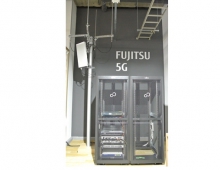
Fujitsu Achieves 40-Gbps Optical-Fiber Transmission Using Directly-Modulated Laser Without Need for Cooling
Fujitsu today announced the achievement of a 40 gigabits per second (40-Gbps) optical-fiber transmission employing an uncooled directly-modulated laser, which isprimarily used in short-distance communications.
This was realized through the combination of a structure specifically adapted to high-speed operation, and a newly-developed structure capable of lowering operating current and enabling high-temperature operation. Featuring power consumption at less than half that of commercialized 40-Gbps optical transmitters, Fujitsu's new directly-modulated laser obviates the need for a thermoelectric controller. This achievement represents a major step toward lowering the power consumption of the next generation of high-speed optical communications.
Details of this technology were presented at the Optical Fiber Communication Conference and Exposition/National Fiber Optic Engineers Conference 2011 (OFC/NFOEC 2011) being held in Los Angeles from March 6-10.
Background
In optical communications, in which high volumes of data are transmitted at high speed using light, converting electrical signals to optical signals requires a light source for which intensity of light output can be modulated. There are two main methods for modulation: direct modulation, for which input current to a semiconductor laser is modulated; and external modulation, in which a light source from a semiconductor laser is modulated by an external optical modulator. Direct modulation is primarily used for low-speed, short-distance transmissions, while external modulation is mainly employed for high-speed, long-distance transmissions.
For transmissions at speeds up to 10-Gbps, directly-modulated lasers are being used that do not require a thermoelectric controller or cooling, allowing them to be more compact and operate on less power. For high-speed communications that exceed 10-Gbps, external modulation by lasers with integrated electro-absorption modulators have been used for short-distance transmissions up to 10 km. But in order to stably operate lasers with integrated electro-absorption modulators, more than half their total power use needs to be dedicated to cooling via a thermoelectric controller, presenting an obstacle to lowering the power consumed.
To create compact, energy-efficient equipment that can accommodate the high-capacity optical communications that will be increasingly prevalent, there are needs for directly-modulated lasers that can operate at speeds of over 10-Gbps without the need for cooling. This, in turn, would require high-speed direct-modulation at a low driving current.
Fujitsu has developed a directly-modulated laser that operates at 40-Gbps in the 1.3 ΅m wavelength band. The technology has resulted in the world's first successful 40-Gbps single-mode optical fiber transmission over 5 km, for a directly-modulated laser featuring an operation temperature range of 25°C to 70°C.
Fujitsu plans to continue with further development of this technology to extend the upper temperature range and distances over which this new technology can operate, while making improvements to the device's structure and manufacturing process technologies, and is proceeding with R&D targeting practical use.
Details of this technology were presented at the Optical Fiber Communication Conference and Exposition/National Fiber Optic Engineers Conference 2011 (OFC/NFOEC 2011) being held in Los Angeles from March 6-10.
Background
In optical communications, in which high volumes of data are transmitted at high speed using light, converting electrical signals to optical signals requires a light source for which intensity of light output can be modulated. There are two main methods for modulation: direct modulation, for which input current to a semiconductor laser is modulated; and external modulation, in which a light source from a semiconductor laser is modulated by an external optical modulator. Direct modulation is primarily used for low-speed, short-distance transmissions, while external modulation is mainly employed for high-speed, long-distance transmissions.
For transmissions at speeds up to 10-Gbps, directly-modulated lasers are being used that do not require a thermoelectric controller or cooling, allowing them to be more compact and operate on less power. For high-speed communications that exceed 10-Gbps, external modulation by lasers with integrated electro-absorption modulators have been used for short-distance transmissions up to 10 km. But in order to stably operate lasers with integrated electro-absorption modulators, more than half their total power use needs to be dedicated to cooling via a thermoelectric controller, presenting an obstacle to lowering the power consumed.
To create compact, energy-efficient equipment that can accommodate the high-capacity optical communications that will be increasingly prevalent, there are needs for directly-modulated lasers that can operate at speeds of over 10-Gbps without the need for cooling. This, in turn, would require high-speed direct-modulation at a low driving current.
Fujitsu has developed a directly-modulated laser that operates at 40-Gbps in the 1.3 ΅m wavelength band. The technology has resulted in the world's first successful 40-Gbps single-mode optical fiber transmission over 5 km, for a directly-modulated laser featuring an operation temperature range of 25°C to 70°C.
Fujitsu plans to continue with further development of this technology to extend the upper temperature range and distances over which this new technology can operate, while making improvements to the device's structure and manufacturing process technologies, and is proceeding with R&D targeting practical use.





















